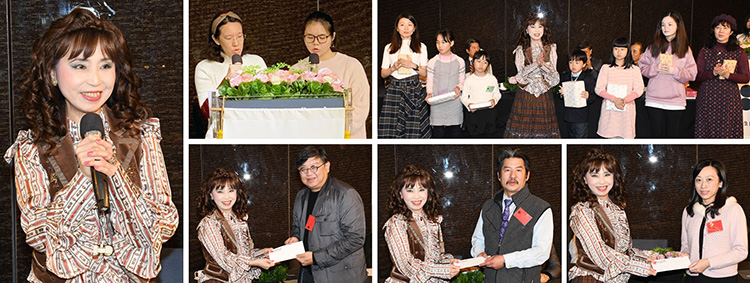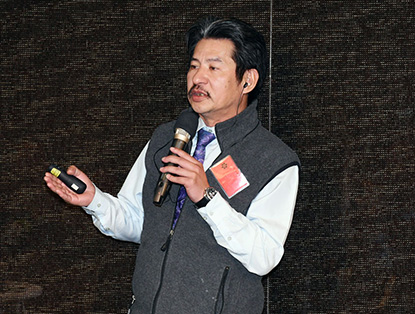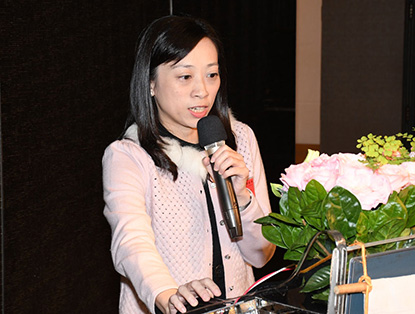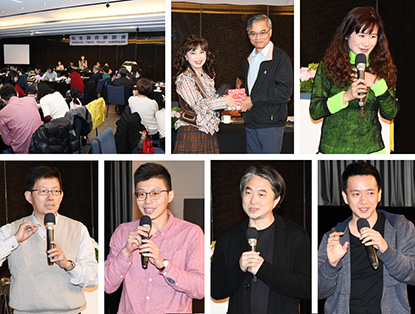Sketch of Public Policy Communion, January 2020Date: 2020-02-19
Section: Activity | 
本會於2020年1月19日假台北喜來登大飯店一樓清翫廳舉行「祐生國政聯誼會」。在主持人黃晉英秘書長宣布後揭開當日活動序幕,在輕鬆、活潑的節目之下,隨即由主持人帶來重要訊息:「氣候異變在全球各地不斷傳出災情,於此情景下,提醒祐生成員們應保有清晰的中心思想,避免人云亦云。而歷經三年時光沉潛,第三任第二階段潛鋒特組會議再次於2019年10月26日召開,潛鋒特組也將邁向「2.0」版本,建立與生活相關之「潛鋒指數」,預測未來趨勢,有助於行事準則的確立。另外,十七年前出版之「正義與慈悲」,目前將推出復刻版,當時訪問的26位人物中也包含我與蔡英文總統,未來,在座各位都可能成為社會上舉足輕重的人物,故應謹慎當前的舉止及掌握做事的原則。」
The January Archilife Public Policy Communion of 2020 was held on January 19, 2020. After a series of relaxing and fun activities, Secretary General Huang Chin-ying made the following announcement, "Climate change has constantly caused disasters around the world. Given the situation, Achilife members are reminded to be clear about their central idea, refrain from repeating what others say and give constructive suggestions for the country and society. After three years of silence, the third stage-2 Pioneer Special Team meeting was held on October 26th, 2019 and the Pioneer Special Team will move towards the "2.0" version, establish life-related "Pioneer indicators", and predict future trends, which will be conducive to the establishment of a code of conduct. In addition, the re-engraved version of "Justice and Mercy" published 17 years ago will be released. The 26 persons interviewed also include President Tsai Ing-wen and myself. In the future, all of you present today may become somebody in the society. Therefore, we should be cautious with our manners and grasp the principle of doing things."
 緊接著進行專題演講,由國政會委員周伯丞先生主講「國際永續與健康指標及其與地方政策之對標」。主講人首先說明包浩斯學校對於現代建築學有著深遠影響。主講人接著提到日本NEXT21實驗住宅,以植栽改變基地微氣候溫度,對應都市的熱島效應。針對聯合國提出17項永續發展目標(SDGs),也嘗試與手邊的業務工作做對標。主講人表示推動的「高雄厝計畫」,設計準則即與聯合國SDGs對應,有效規劃建立高雄永續居住環境改造。主講人也提出設置景觀陽臺之案例,可有效降低居家室內溫度,具有美化居住環境及提昇生活品質的好處。 緊接著進行專題演講,由國政會委員周伯丞先生主講「國際永續與健康指標及其與地方政策之對標」。主講人首先說明包浩斯學校對於現代建築學有著深遠影響。主講人接著提到日本NEXT21實驗住宅,以植栽改變基地微氣候溫度,對應都市的熱島效應。針對聯合國提出17項永續發展目標(SDGs),也嘗試與手邊的業務工作做對標。主講人表示推動的「高雄厝計畫」,設計準則即與聯合國SDGs對應,有效規劃建立高雄永續居住環境改造。主講人也提出設置景觀陽臺之案例,可有效降低居家室內溫度,具有美化居住環境及提昇生活品質的好處。
Next on the schedule was the keynote speech. First, Mr. Chou Po-cheng gave a presentation on "International Sustainability and Health Indicators and Other Policy Benchmarking". First, the speaker explained the profound influence of Staatliches Bauhaus on modern architecture. The presenter went on about Japan’s NEXT21 experimental housing that provides a lifestyle in harmony with nature, uses plants to change the microclimate and temperature of the base in response to the urban heat island effect. Targeting the 17 SDGs proposed by the United Nations, we also attempted to benchmark ongoing businesses. The presenter said the promotion of the design criteria of the "Kaohsiung Housing Plan" corresponded to the UN’s SDGs, effectively planning and establishing sustainable living environment transformation in Kaohsiung. The presenter also cited cases of landscape balconies that effectively reduce the home indoor temperature and have the advantages of beautifying the living environment and improving the quality of life.
 接著由國政會委員戴永禔先生主講「大學裡的部落」。主講人首先表示工業文明結束後,大學的角色轉變,面對未來新文明,大學應培養能因應複雜變局的人才。主講人認為原住民文化對於新文明具關鍵性。接著提到於中原大學開設設計學士原住民專班,課程包括原住民文化與社會設計、媒體藝術、語境空間及共生環境,並進行部落化教學,藉由習慣的養成與重複的練習,使身體自然記憶,課程採取共授支援、混級教學。主講人也帶領學生親身前進部落,期望使學生畢業之後有機會回歸部落。而原住民學生多數經濟較為弱勢,故學校除傳授知識外,也研擬辦法照顧學生生活,招生的對象也強調願意學習、為他人著想及具合作精神。 接著由國政會委員戴永禔先生主講「大學裡的部落」。主講人首先表示工業文明結束後,大學的角色轉變,面對未來新文明,大學應培養能因應複雜變局的人才。主講人認為原住民文化對於新文明具關鍵性。接著提到於中原大學開設設計學士原住民專班,課程包括原住民文化與社會設計、媒體藝術、語境空間及共生環境,並進行部落化教學,藉由習慣的養成與重複的練習,使身體自然記憶,課程採取共授支援、混級教學。主講人也帶領學生親身前進部落,期望使學生畢業之後有機會回歸部落。而原住民學生多數經濟較為弱勢,故學校除傳授知識外,也研擬辦法照顧學生生活,招生的對象也強調願意學習、為他人著想及具合作精神。
Next, Mr. Tai Yung-ti, spoke on "Indigenous Community in Universities". First, the speaker said that the role of the university has changed. Faced with a new civilization in the future, universities should foster talents capable of coping with complex changes. The presenter believes that the indigenous culture is key to the new civilization. He went on about the Chung Yuan Christian University’s commencement of Bachelor Program in Design for Indigenous Students. The courses include indigenous culture and social design, media art and contextual space and symbiotic environment. Tribal teaching was also conducted. By developing habits and practicing repeatedly, the body naturally memorized. The courses adopted co-teaching support and mixed-level teaching. The presenter also led the students into the tribe, hoping that the students could have the opportunity to return to the tribe upon graduation. Indigenous students are relatively economically disadvantaged. Hence, in addition to imparting knowledge, the school has also formulated guidelines to take care of students in daily life, giving emphasis to recruiting students with the "willingness to learn," "consideration for others" and "teamwork spirit".
 接著由國政會委員葉娟礽小姐主講「鑒觀民樂·文化興國」。主講人首先表示「文化興國」應迎向豐富民眾日常生活價值內涵的積極作用力,建構循環型的社會、經濟、環境。在前瞻基礎建設計畫中,臺灣音樂年鑑編輯計畫為重要研究基礎,系因年鑑採逐年系統性彙輯,為連續出版的文獻書籍,其資料相對完整,內容具有權威性和時間性,因而具有資政、鑒戒和史料作用。此計畫調查記錄全年臺灣音樂活動,觀察面向包括展演活動、祭儀活動、推廣教育、傳習活動、國際與兩岸交流、研究與出版及文化政策。主講人現場亦播放相關展演音樂,悠揚或磅礡旋律中,使與會者彷彿身歷其境。 接著由國政會委員葉娟礽小姐主講「鑒觀民樂·文化興國」。主講人首先表示「文化興國」應迎向豐富民眾日常生活價值內涵的積極作用力,建構循環型的社會、經濟、環境。在前瞻基礎建設計畫中,臺灣音樂年鑑編輯計畫為重要研究基礎,系因年鑑採逐年系統性彙輯,為連續出版的文獻書籍,其資料相對完整,內容具有權威性和時間性,因而具有資政、鑒戒和史料作用。此計畫調查記錄全年臺灣音樂活動,觀察面向包括展演活動、祭儀活動、推廣教育、傳習活動、國際與兩岸交流、研究與出版及文化政策。主講人現場亦播放相關展演音樂,悠揚或磅礡旋律中,使與會者彷彿身歷其境。
Next, Ms. Yeh Jiuan-reng, spoke on "Insights into Folk Music and Culture Leading to National Prosperity". First, the speaker said "culture leading to national prosperity" should be directed towards the positive force that enriches the value and connotation of people’s daily lives, building a circular society, economy and environment. In the forward-looking infrastructure plan, Taiwan’s music yearbook editing plan is an important research basis, because the yearbook is an annual and systematic collection of continuously published informational and literature books, with relatively complete information and authoritative and time-based contents. The plan survey records year-round music events in Taiwan. The observation aspects include exhibition events, ceremonial events, promotion education, traditional customary events, international and cross-strait exchanges, research and publication and cultural policies. The presenter also played live relevant exhibition music that with the melodious or majestic music, the participants felt as if they were personally on the scene.
 演講完畢,黃晉英秘書長代表基金會致贈謝禮予主講人,同時臨場進行機智問答。接著在與會者紛紛利用「餵豬時間」提出個人意見與看法互相交流後,圓滿地結束一月份國政聯誼會。 演講完畢,黃晉英秘書長代表基金會致贈謝禮予主講人,同時臨場進行機智問答。接著在與會者紛紛利用「餵豬時間」提出個人意見與看法互相交流後,圓滿地結束一月份國政聯誼會。
After the speech, Secretary General Huang Chin-ying presented a gift to the speakers on behalf of the foundation, and played a brainstorm game. Then, attendees expressed and exchanged their opinions and views during the piggy hour. The January Archilife Public Policy Communion ended smoothly.
|
|